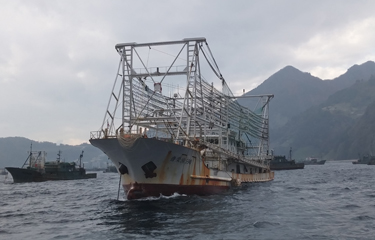A new study has uncovered a massive illegal fishing operation conducted by Chinese fishing vessels in North Korean waters.
The study, Illuminating Dark Fishing Fleets in North Korea, found at least 700 vessels of Chinese origin had fished illegally in North Korean waters in 2018, and that more than 900 had done so in 2017 – in violation of United Nations sanctions. It estimated the illegal take of Pacific flying squid from the participating vessels is more than 160,000 metric tons, worth over USD 440 million (EUR 380.2 million) in 2017-2018. The total take is greater than the entire catch of the fishing fleets of Japan and South Korea combined. The study found that such large, unregulated catches are depleting squid stocks in the region, with squid populations plummeting by 80 percent and 82 percent in South Korean and Japanese waters, respectively, since 2003.
Published on 22 July in Science Advances, the study was completed by scientists from South Korea, Japan, Australia, and the United States, using data provided by Global Fishing Watch, a partnership between Google and the advocacy groups Oceana and SkyTruth that collects fishing vessel location information collected by satellite.
The detected vessels often do not carry appropriate papers, according to Global Fishing Watch, which dubbed them “three-no boats”— meaning they operate without official Chinese authority, with no registrations, flags, or licenses. However, the group said it tracked the vessels back to China and it assumes they are owned and operated by Chinese companies.
“The scale of the fleet involved in this illegal fishing is about one-third the size of China's entire distant-water fishing fleet. It is the largest known case of illegal fishing perpetrated by vessels originating from one country operating in another nation’s waters,” Global Fishing Watch Senior Data Scientist Jaeyoon Park, a co-lead author of the study, said in a press release. “By synthesizing data from multiple satellite sensors, we created an unprecedented, robust picture of fishing activity in a notoriously opaque region.”
Tracking fishing patterns by Chinese and North Korean vessels operating in the East Sea, or Sea of Japan, is notoriously difficult as both fleets are known not to publicly broadcast their location or appear in public monitoring systems. Often, these vessels do not carry automatic identification system (AIS), a collision avoidance system that constantly transmits a vessel’s location at sea, which provides detailed vessel location information. Additionally, the waters are some of the world’s most contested and poorly monitored, according to Global Fishing Watch, with boundary disputes between the Koreas, Japan, and Russia preventing fisheries management and hindering national efforts due to a lack of comprehensive stock assessments.
“Illegal fishing in these waters is a very serious matter in Japan, and the lack of shared data and management is a major challenge considering the critical importance of squid in the region,” Japan Fisheries Research and Education Agency President Masanori Miyahara said in the release. “We must face this challenge using the evidence provided by this study and other credible science.”
To gather data, the authors of the study used other satellite technologies, including radar images, which can identify large metal vessels and penetrate clouds; nighttime imaging, which can identify the presence of fishing vessels using lights to attract catch or conduct operations at night; and high-resolution optical imagery, which offers the best visual “proof” of vessel activity and type, according to Global Fishing Watch.
“These technologies have never before been combined to publicly reveal the activities and estimated catches of entire fleets at this scale,” the group said.
The new technology is proving capable of tracking previously undetectable incidences of illegal, unreported, and unregulated (IUU) fishing, according to Global Fishing Watch Research and Innovation Director David Kroodsma.
“These novel insights are now possible thanks to advances in machine learning and the rapidly growing volume of high-resolution, high-frequency imagery that was unavailable even a couple of years ago,” said Kroodsma, who also co-authored the study. “We’ve shown we can track industrial fishing vessels that are not broadcasting their locations.”
The study also revealed a secondary illegal fishing operation occurring as a result of the first, with approximately 3,000 North Korean vessels illegally fishing in Russian waters in 2018. Despite efforts by Russian authorities to deter North Korean fishermen from entering the country’s exclusive economic zone to fish, the sheer number of North Korean vessels fishing illegally is preventing Russian companies from fishing in the area and is contributing to overfishing in the area.
“Competition from the industrial Chinese trawlers is likely displacing the North Korean fishers, pushing them into neighboring Russian waters,” study co-lead Jungsam Lee of the Korea Maritime Institute said. “The North Koreans’ smaller wood boats are ill-equipped for this long-distance travel.”
The longer trips being made by the North Korean boats have lead to disappearances and deaths of an untold number of fishermen, according to University of California, Santa Cruz Assistant Professor Katherine Seto, another of the study’s co-authors.
"The consequences of this shifting effort for North Korean small-scale fishers are profound, and represent an alarming and potentially growing human rights concern," Seto said.
Quentin Hanich, an associate professor at the University of Wollongong’s Australian National Centre for Ocean Resources and Security and another co-author, said he was hopeful for a positive outcome as a result of the study. The 2018 inter-Korean summits underlined the need to build peace through cooperation on the waters, create a joint fisheries management area, and address illegal fishing, he said, and the study presents unbiased information that all sides can trust and work off of to improve outcomes in the region.
“Global fisheries have long been dominated by a culture of unnecessary confidentiality and concealment,” Hanich said. “Achieving a comprehensive view of fishing activity is an important step toward truly sustainable and cooperative fisheries management, and satellite monitoring is a key part of the solution. This analysis represents the beginning of a new era in ocean management and transparency.”
Photo courtesy of Ulleung-gun County Office/Global Fishing Watch







